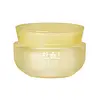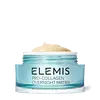What's inside
What's inside
 Key Ingredients
Key Ingredients

 Benefits
Benefits

 Concerns
Concerns

 Ingredients Side-by-side
Ingredients Side-by-side

Water
Skin ConditioningGlycerin
HumectantButylene Glycol
HumectantMethyl Trimethicone
Skin ConditioningHydrogenated Poly(C6-14 Olefin)
EmollientTrehalose
HumectantNiacinamide
SmoothingAlcohol
AntimicrobialPCA Dimethicone
Skin Conditioning1,2-Hexanediol
Skin ConditioningBehenyl Alcohol
EmollientJojoba Esters
EmollientAcrylates/C10-30 Alkyl Acrylate Crosspolymer
Emulsion StabilisingCnidium Officinale Root Water
MaskingAngelica Acutiloba Root Water
Skin ConditioningHydroxyethyl Acrylate/Sodium Acryloyldimethyl Taurate Copolymer
Emulsion StabilisingHelianthus Annuus Seed Oil
EmollientLimonene
PerfumingAmmonium Acryloyldimethyltaurate/Beheneth-25 Methacrylate Crosspolymer
Emulsion StabilisingTromethamine
BufferingCitrus Junos Peel Oil
AstringentXanthan Gum
EmulsifyingGlyceryl Caprylate
EmollientDaucus Carota Sativa Root Extract
Skin ConditioningDisodium EDTA
Ethylhexylglycerin
Skin ConditioningGeraniol
PerfumingAdenosine
Skin ConditioningSorbitan Isostearate
EmulsifyingLinalool
Perfuming3-O-Ethyl Ascorbic Acid
Skin ConditioningBeta-Carotene
Skin ConditioningFarnesol
PerfumingTocopherol
AntioxidantCymbopogon Martini Oil
MaskingCitrus Junos Peel Extract
Skin ConditioningWater, Glycerin, Butylene Glycol, Methyl Trimethicone, Hydrogenated Poly(C6-14 Olefin), Trehalose, Niacinamide, Alcohol, PCA Dimethicone, 1,2-Hexanediol, Behenyl Alcohol, Jojoba Esters, Acrylates/C10-30 Alkyl Acrylate Crosspolymer, Cnidium Officinale Root Water, Angelica Acutiloba Root Water, Hydroxyethyl Acrylate/Sodium Acryloyldimethyl Taurate Copolymer, Helianthus Annuus Seed Oil, Limonene, Ammonium Acryloyldimethyltaurate/Beheneth-25 Methacrylate Crosspolymer, Tromethamine, Citrus Junos Peel Oil, Xanthan Gum, Glyceryl Caprylate, Daucus Carota Sativa Root Extract, Disodium EDTA, Ethylhexylglycerin, Geraniol, Adenosine, Sorbitan Isostearate, Linalool, 3-O-Ethyl Ascorbic Acid, Beta-Carotene, Farnesol, Tocopherol, Cymbopogon Martini Oil, Citrus Junos Peel Extract
Water
Skin ConditioningGlycerin
HumectantOlus Oil
EmollientPropanediol
SolventBehenyl Alcohol
EmollientSqualane
EmollientButylene Glycol
HumectantOctyldodecanol
EmollientDicaprylyl Carbonate
EmollientHelianthus Annuus Seed Oil
EmollientPhenoxyethanol
PreservativeAcrylates/C10-30 Alkyl Acrylate Crosspolymer
Emulsion StabilisingBeheneth-25
CleansingGlyceryl Acrylate/Acrylic Acid Copolymer
HumectantBenzoic Acid
MaskingLavandula Angustifolia Oil
MaskingDisodium EDTA
Dunaliella Salina Extract
Skin ConditioningRhizobian Gum
Sodium Hyaluronate
HumectantDehydroacetic Acid
PreservativeLinalool
PerfumingLavandula Hybrida Oil
EmollientPelargonium Graveolens Flower Oil
MaskingPadina Pavonica Thallus Extract
Skin ConditioningGeraniol
PerfumingEucalyptus Globulus Leaf Oil
PerfumingChlorphenesin
AntimicrobialPlankton Extract
Skin ConditioningAnthemis Nobilis Flower Oil
MaskingCitronellol
PerfumingPotassium Sorbate
PreservativeSodium Benzoate
MaskingCaramel
Cosmetic ColorantCinnamomum Camphora Wood Oil
MaskingLimonene
PerfumingMentha Arvensis Leaf Oil
MaskingTocopherol
AntioxidantXanthan Gum
EmulsifyingCaprylyl Glycol
EmollientCitrus Aurantium Dulcis Oil
MaskingParfum
MaskingTephrosia Purpurea Seed Extract
Skin ConditioningVitis Vinifera Seed Oil
EmollientMenthol
MaskingEugenia Caryophyllus Leaf Oil
MaskingSodium Hydroxide
BufferingGlyceryl Caprylate
EmollientLactic Acid/Glycolic Acid Copolymer
Skin ConditioningPhenylpropanol
MaskingPalmitoyl Tetrapeptide-50
Skin ConditioningPolyvinyl Alcohol
Heptapeptide-15 Palmitate
Skin ConditioningWater, Glycerin, Olus Oil, Propanediol, Behenyl Alcohol, Squalane, Butylene Glycol, Octyldodecanol, Dicaprylyl Carbonate, Helianthus Annuus Seed Oil, Phenoxyethanol, Acrylates/C10-30 Alkyl Acrylate Crosspolymer, Beheneth-25, Glyceryl Acrylate/Acrylic Acid Copolymer, Benzoic Acid, Lavandula Angustifolia Oil, Disodium EDTA, Dunaliella Salina Extract, Rhizobian Gum, Sodium Hyaluronate, Dehydroacetic Acid, Linalool, Lavandula Hybrida Oil, Pelargonium Graveolens Flower Oil, Padina Pavonica Thallus Extract, Geraniol, Eucalyptus Globulus Leaf Oil, Chlorphenesin, Plankton Extract, Anthemis Nobilis Flower Oil, Citronellol, Potassium Sorbate, Sodium Benzoate, Caramel, Cinnamomum Camphora Wood Oil, Limonene, Mentha Arvensis Leaf Oil, Tocopherol, Xanthan Gum, Caprylyl Glycol, Citrus Aurantium Dulcis Oil, Parfum, Tephrosia Purpurea Seed Extract, Vitis Vinifera Seed Oil, Menthol, Eugenia Caryophyllus Leaf Oil, Sodium Hydroxide, Glyceryl Caprylate, Lactic Acid/Glycolic Acid Copolymer, Phenylpropanol, Palmitoyl Tetrapeptide-50, Polyvinyl Alcohol, Heptapeptide-15 Palmitate
Ingredients Explained
These ingredients are found in both products.
Ingredients higher up in an ingredient list are typically present in a larger amount.
Acrylates/C10-30 Alkyl Acrylate Crosspolymer is a synthetic polymer. It is used to thicken and improve the texture of products. Due to its properties, it can prevent water and oil ingredients from separating.
Behenyl Alcohol is a type of fatty alcohol (these are different from the drying, solvent alcohols).
Fatty Alcohols have hydrating properties and are most often used as an emollient or to thicken a product. They are usually derived from natural fats and oils; behenyl alcohol is derived from the fats of vegetable oils.
Emollients help keep your skin soft and hydrated by creating a film that traps moisture in.
In 2000, Behenyl Alcohol was approved by the US as medicine to reduce the duration of cold sores.
Learn more about Behenyl AlcoholButylene Glycol (or BG) is used within cosmetic products for a few different reasons:
Overall, Butylene Glycol is a safe and well-rounded ingredient that works well with other ingredients.
Though this ingredient works well with most skin types, some people with sensitive skin may experience a reaction such as allergic rashes, closed comedones, or itchiness.
Learn more about Butylene GlycolDisodium EDTA plays a role in making products more stable by aiding other preservatives.
It is a chelating agent, meaning it neutralizes metal ions that may be found in a product.
Disodium EDTA is a salt of edetic acid and is found to be safe in cosmetic ingredients.
Learn more about Disodium EDTAGeraniol is used to add fragrance/parfum to a product. It is the main component of citronellol. It is a monoterpenoid and an alcohol.
Monoterpenes are naturally found in many parts of different plants.
Geraniol can be found in many essential oils including Rose Oil and Citronella Oil. The scent of Geraniol is often described as "rose-like". Many foods also contain Geraniol for fruit flavoring.
Geraniol can irritate the skin when exposed to air. However, irritation depends on the ability of geraniol to penetrate into the skin. In general, geraniol is not able to penetrate skin easily.
Geraniol is colorless and has low water-solubility. However, it is soluble in common organic solvents.
Like citronellol, it is a natural insect repellent.
2,6-Octadien-1-ol, 3,7-dimethyl-, (2E)-
Learn more about GeraniolGlycerin is already naturally found in your skin. It helps moisturize and protect your skin.
A study from 2016 found glycerin to be more effective as a humectant than AHAs and hyaluronic acid.
As a humectant, it helps the skin stay hydrated by pulling moisture to your skin. The low molecular weight of glycerin allows it to pull moisture into the deeper layers of your skin.
Hydrated skin improves your skin barrier; Your skin barrier helps protect against irritants and bacteria.
Glycerin has also been found to have antimicrobial and antiviral properties. Due to these properties, glycerin is often used in wound and burn treatments.
In cosmetics, glycerin is usually derived from plants such as soybean or palm. However, it can also be sourced from animals, such as tallow or animal fat.
This ingredient is organic, colorless, odorless, and non-toxic.
Glycerin is the name for this ingredient in American English. British English uses Glycerol/Glycerine.
Learn more about GlycerinGlyceryl Caprylate comes from glycerin and caprylic acid, a fatty acid from coconut. It has emollient and emulsifier properties.
As an emollient, it helps hydrate your skin. Emollients work by creating a barrier on your skin to trap moisture in, helping to keep your skin soft and smooth.
On the other hand, emulsifiers prevent ingredients (such as oil and water) from separating.
Learn more about Glyceryl CaprylateHelianthus Annuus Seed Oil is the oil derived from the seeds of a Sunflower. Sunflower seed oil is non-fragrant. It is an emollient, meaning it helps to soften the skin.
Sunflower seed oil contains many fatty acids. The fatty acids found in sunflower seeds include (from highest amount to least): linoleic acid, myristic acid, palmitic acid, stearic acid, arachidic acid, oleic acid, and linolenic acid.
These fatty acids help the skin create ceramides. Ceramides play a role in repairing the skin barrier.
Helianthus Annuus Seed Oil helps moisturize the skin. This in turn helps the skin look more rejuvenated and smoother.
Sunflowers are rich in vitamin E.
Historians believe Indigenous cultures of North America domesticated sunflowers before corn. Thus they relied on sunflower oil for a variety of uses. One such use is moisturizing skin and hair.
Sunflower seed oil may not be fungal acne safe. We recommend speaking with a professional if you have any concerns.
Learn more about Helianthus Annuus Seed OilLimonene is a fragrance that adds scent and taste to a formulation.
It's found in the peel oil of citrus fruits and other plants such as lavender and eucalyptus. The scent of limonene is generally described as "sweet citrus".
Limonene acts as an antioxidant, meaning it helps neutralize free radicals.
When exposed to air, oxidized limonene may sensitize the skin. Because of this, limonene is often avoided by people with sensitive skin.
The term 'fragrance' is not regulated in many countries. In many cases, it is up to the brand to define this term. For instance, many brands choose to label themselves as "fragrance-free" because they are not using synthetic fragrances. However, their products may still contain ingredients such as essential oils that are considered a fragrance.
Learn more about LimoneneLinalool is a fragrance and helps add scent to products. It's derived from common plants such as cinnamon, mint, citrus, and lavender.
Like Limonene, this ingredient oxidizes when exposed to air. Oxidized linalool can cause allergies and skin sensitivity.
This ingredient has a scent that is floral, spicy tropical, and citrus-like.
Learn more about LinaloolTocopherol (also known as Vitamin E) is a common antioxidant used to help protect the skin from free-radicals and strengthen the skin barrier. It's also fat soluble - this means our skin is great at absorbing it.
Vitamin E also helps keep your natural skin lipids healthy. Your lipid skin barrier naturally consists of lipids, ceramides, and fatty acids. Vitamin E offers extra protection for your skin’s lipid barrier, keeping your skin healthy and nourished.
Another benefit is a bit of UV protection. Vitamin E helps reduce the damage caused by UVB rays. (It should not replace your sunscreen). Combining it with Vitamin C can decrease sunburned cells and hyperpigmentation after UV exposure.
You might have noticed Vitamin E + C often paired together. This is because it is great at stabilizing Vitamin C. Using the two together helps increase the effectiveness of both ingredients.
There are often claims that Vitamin E can reduce/prevent scarring, but these claims haven't been confirmed by scientific research.
Learn more about TocopherolWater. It's the most common cosmetic ingredient of all. You'll usually see it at the top of ingredient lists, meaning that it makes up the largest part of the product.
So why is it so popular? Water most often acts as a solvent - this means that it helps dissolve other ingredients into the formulation.
You'll also recognize water as that liquid we all need to stay alive. If you see this, drink a glass of water. Stay hydrated!
Learn more about WaterXanthan gum is used as a stabilizer and thickener within cosmetic products. It helps give products a sticky, thick feeling - preventing them from being too runny.
On the technical side of things, xanthan gum is a polysaccharide - a combination consisting of multiple sugar molecules bonded together.
Xanthan gum is a pretty common and great ingredient. It is a natural, non-toxic, non-irritating ingredient that is also commonly used in food products.
Learn more about Xanthan Gum